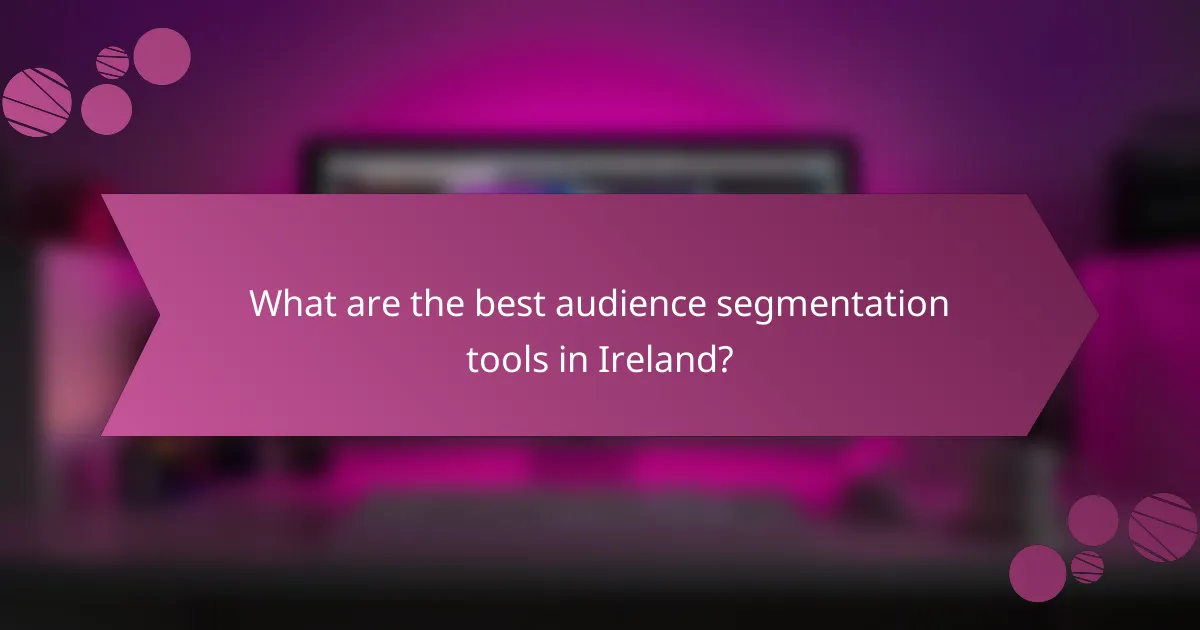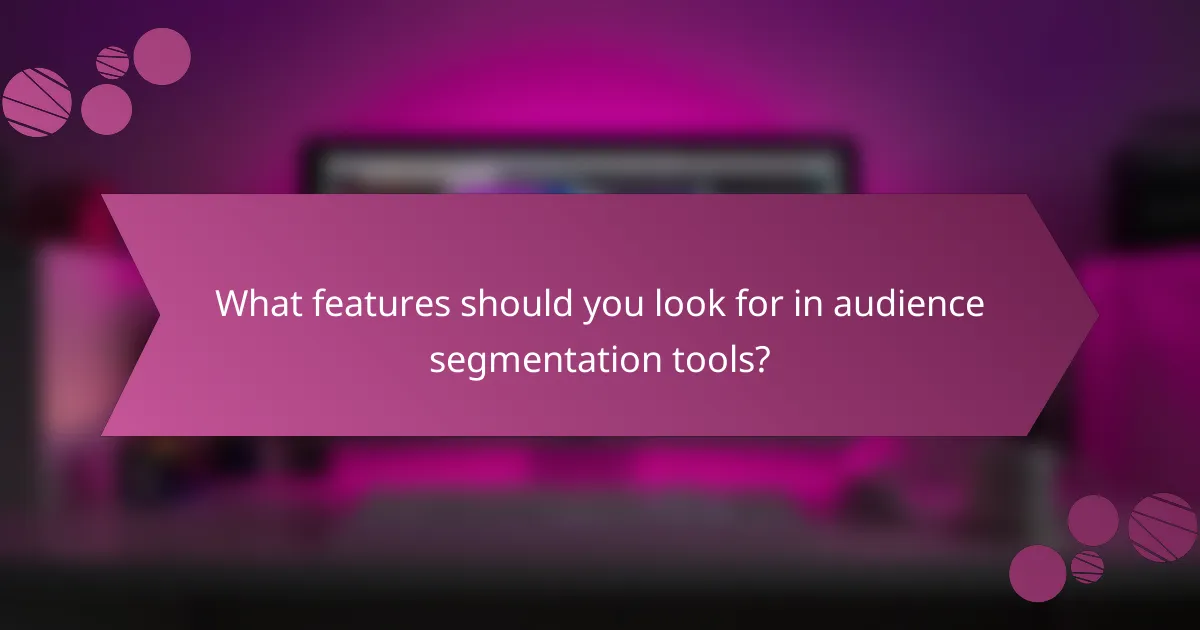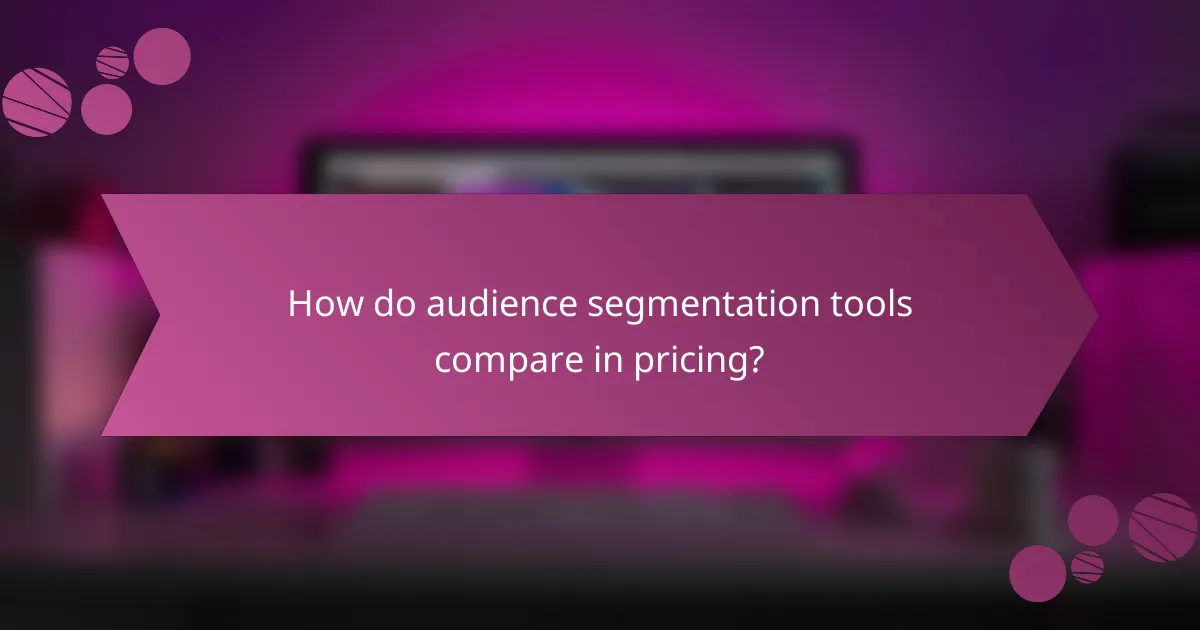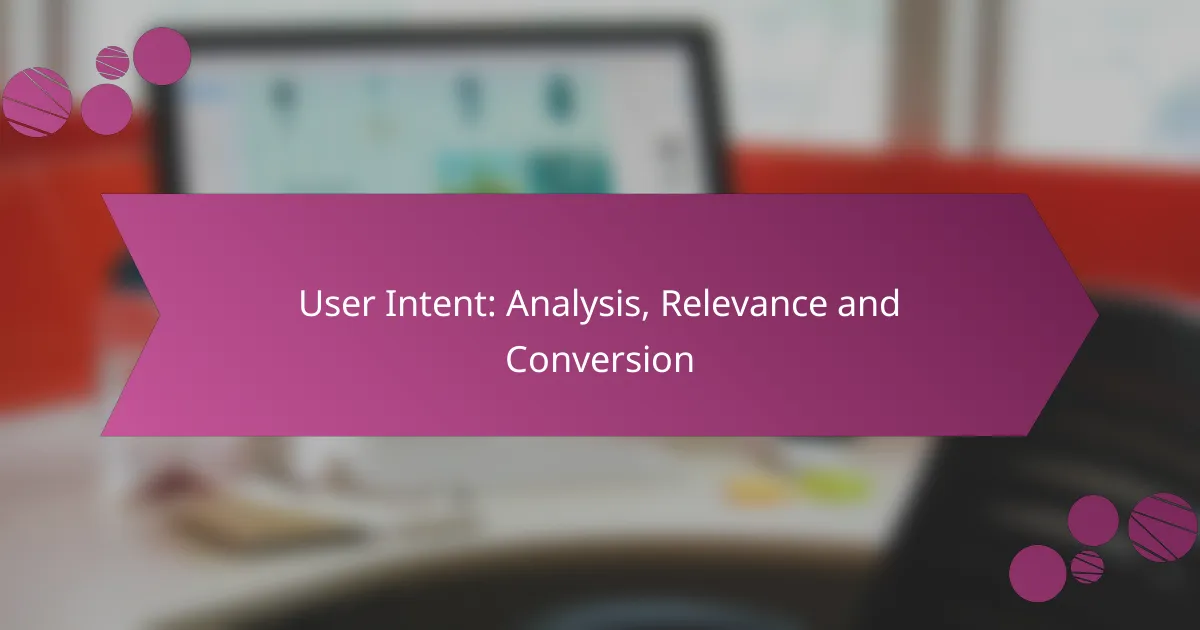Audience segmentation tools are essential for businesses looking to optimize their marketing strategies by effectively targeting specific customer groups. These tools analyze customer data and behavior, enabling marketers to create more relevant ads that enhance engagement and conversion rates. When choosing the right tool, it’s important to consider features like data integration, user experience, and real-time analytics to maximize efficiency.

What are the best audience segmentation tools in Ireland?
The best audience segmentation tools in Ireland include options that cater to various marketing needs, such as data analysis, customer relationship management, and email marketing. These tools help businesses effectively target their audiences by analyzing customer data and behavior.
Google Analytics 4
Google Analytics 4 (GA4) is a powerful tool for audience segmentation, focusing on user interactions across multiple platforms. It allows marketers to create segments based on user behavior, demographics, and engagement metrics.
To leverage GA4 effectively, set up conversion tracking and utilize the audience builder to create tailored segments. This can help in understanding customer journeys and optimizing marketing strategies based on real-time data.
HubSpot Marketing Hub
HubSpot Marketing Hub offers robust audience segmentation features integrated with its CRM capabilities. Users can segment contacts based on various criteria, including lifecycle stage, behavior, and engagement levels.
Consider using HubSpot’s workflows to automate marketing efforts for different segments. This can enhance personalization and improve conversion rates, making it a valuable tool for businesses looking to engage their audience effectively.
Segment
Segment is a customer data platform that enables businesses to collect, unify, and activate their customer data for segmentation. It allows for real-time data integration from various sources, making it easier to create detailed audience segments.
When using Segment, focus on defining clear data sources and ensuring data quality. This will help in creating accurate segments that reflect your audience’s behavior and preferences, ultimately driving better marketing outcomes.
Mailchimp
Mailchimp is widely known for its email marketing capabilities, but it also offers effective audience segmentation tools. Users can segment their email lists based on demographics, purchase history, and engagement metrics.
Utilize Mailchimp’s predictive segmentation feature to identify potential high-value customers. This can help in tailoring email campaigns to specific segments, improving open rates and conversions.
ActiveCampaign
ActiveCampaign combines email marketing with advanced segmentation and automation features. It allows users to create segments based on user behavior, engagement, and other criteria, facilitating targeted marketing efforts.
To maximize ActiveCampaign’s potential, take advantage of its automation workflows to send personalized messages to different segments. This approach can significantly enhance customer engagement and retention rates.

How do audience segmentation tools improve display advertising?
Audience segmentation tools enhance display advertising by allowing marketers to categorize potential customers into distinct groups based on shared characteristics. This targeted approach leads to more relevant ads, improving engagement and conversion rates.
Enhanced targeting capabilities
Enhanced targeting capabilities enable advertisers to reach specific demographics, interests, and behaviors. By analyzing data such as browsing habits and purchase history, these tools help create tailored ad campaigns that resonate with distinct audience segments.
For example, a clothing retailer can segment its audience into groups like young professionals, parents, and fitness enthusiasts. Each group can receive customized ads that reflect their unique preferences, increasing the likelihood of interaction.
Increased ROI on ad spend
Increased return on investment (ROI) on ad spend is a significant benefit of using audience segmentation tools. By focusing resources on well-defined segments, advertisers can reduce wasted impressions and improve the effectiveness of their campaigns.
Studies suggest that targeted ads can yield conversion rates that are several times higher than generic ads. For instance, a campaign targeting a specific age group may see ROI improvements of 20-30% compared to broader strategies.

What features should you look for in audience segmentation tools?
When selecting audience segmentation tools, prioritize features that enhance data analysis and user experience. Key functionalities include data integration options, a user-friendly interface, real-time analytics, and customizable segmentation capabilities.
Data integration options
Effective audience segmentation tools should offer robust data integration options to connect with various data sources. Look for compatibility with CRM systems, social media platforms, and web analytics tools. This ensures a comprehensive view of your audience by consolidating data from multiple channels.
Consider tools that support APIs or pre-built connectors for seamless integration. The more sources you can integrate, the richer your segmentation insights will be, allowing for more targeted marketing strategies.
User-friendly interface
A user-friendly interface is crucial for maximizing the effectiveness of audience segmentation tools. An intuitive design allows users to navigate features easily, reducing the learning curve and enabling quicker implementation of segmentation strategies.
Look for tools that offer drag-and-drop functionalities, clear visualizations, and straightforward workflows. A well-designed interface can significantly enhance productivity, allowing marketers to focus on strategy rather than getting bogged down by complex software.
Real-time analytics
Real-time analytics are essential for timely decision-making in audience segmentation. Tools that provide immediate insights enable marketers to adjust campaigns based on current data, improving responsiveness and effectiveness.
Choose tools that offer dashboards with live data updates and alerts for significant changes in audience behavior. This capability allows for rapid adjustments to marketing tactics, ensuring that your strategies remain relevant and effective.
Customizable segmentation
Customizable segmentation features allow marketers to tailor audience groups based on specific criteria. This flexibility is vital for creating targeted campaigns that resonate with distinct audience segments.
Look for tools that enable you to define segments based on demographics, behaviors, or engagement levels. The ability to experiment with different criteria can lead to more effective marketing strategies and improved ROI.

How do audience segmentation tools compare in pricing?
Audience segmentation tools vary widely in pricing, with options ranging from free to tiered or usage-based models. Understanding these pricing structures can help businesses choose the right tool based on their budget and needs.
Google Analytics 4 (Free)
Google Analytics 4 offers a robust audience segmentation tool at no cost, making it an attractive option for small businesses and startups. It allows users to create segments based on user behavior, demographics, and technology used.
While the free version provides essential features, businesses with advanced needs may find limitations in data depth and customization. Consider whether the available insights meet your segmentation requirements before relying solely on this tool.
HubSpot Marketing Hub (Tiered pricing)
HubSpot Marketing Hub employs a tiered pricing model, which can range from free to several hundred dollars per month depending on the features selected. This flexibility allows businesses to scale their investment as they grow.
Each tier offers increasingly sophisticated audience segmentation capabilities, including advanced analytics and automation features. Evaluate your business’s size and marketing goals to determine which tier provides the best value for your needs.
Segment (Usage-based pricing)
Segment utilizes a usage-based pricing model, charging businesses based on the volume of data processed. This approach can be cost-effective for companies with fluctuating data needs but may become expensive as data volume increases.
Segment’s pricing structure encourages businesses to optimize their data usage, making it essential to monitor data flow closely. Assess your data requirements and potential growth to ensure this model aligns with your budget.
Mailchimp (Freemium model)
Mailchimp operates on a freemium model, offering basic audience segmentation features for free, with premium options available for more advanced capabilities. This makes it accessible for small businesses looking to start with audience segmentation without upfront costs.
As businesses grow, they can upgrade to paid plans that unlock additional features like advanced analytics and automation. Be mindful of the limitations of the free plan to ensure it meets your initial segmentation needs before considering an upgrade.








